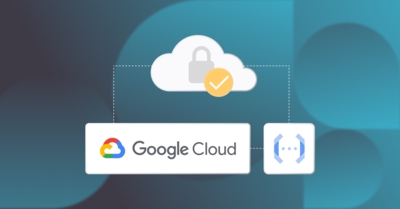Google Cloud’s Cloud Functions is a serverless platform that offers a powerful and scalable way to build event-driven applications. Despite the platform’s strengths, it’s important to carefully manage the access permissions of your cloud functions to ensure they are secure. Lack of secure practices when building and deploying cloud functions can result in unauthorized access and data leaks. This is where the principle of least privilege (PoLP) comes in.
The principle of least privilege is a security concept that ensures users and non-human identities (e.g. service accounts) only have the minimum permissions needed to perform their tasks. This reduces the potential damage if an account is compromised.
In this article, you’ll learn how to implement Cloud Identity and Access Management (IAM) for Cloud Functions with a least privilege approach. You’ll first delve into the core concepts of least privilege and explore how Cloud IAM helps enforce PoLP for your serverless functions. Then you’ll learn how to create and bind unique service accounts to your functions, granting them only the most restricted set of permissions needed for their specific workloads.
What is the principle of least privilege (PoLP)?
PoLP is a fundamental security concept that dictates granting users and non-human identities only the bare minimum permissions required to perform their designated tasks.
By following this principle, software teams can reap many benefits:
- Minimized attack surface: Granting only essential permissions reduces the number of entry points a potential attacker can exploit. A compromised low-privilege account is far less dangerous than one with broad access.
- Safeguards against human error: Accidental mistakes can also lead to security breaches. Least privilege minimizes the impact of such errors by limiting the damage an authorized user with the wrong permissions can cause.
- Prevention of the spread of malware: Malware often relies on elevated privileges to propagate through a system. Least privilege makes it more difficult for malware to gain a foothold and spread laterally.
- Better adherence to compliance: Many compliance regulations mandate the implementation of least privilege to ensure data security. Following this principle demonstrates your commitment to data protection and regulatory compliance.
In the context of Cloud Functions, implementing least privilege ensures your serverless functions operate with the bare minimum permissions needed to access resources and complete their tasks. This significantly strengthens your cloud security posture.
The principle of least privilege in Google Cloud Platform
PoLP can be implemented on Google Cloud Platform (GCP) through service accounts in Cloud IAM. Service accounts are special types of accounts designed to represent non-human users (typically applications or virtual machines). Unlike regular user accounts, service accounts are not tied to individual people.
Each service account has a unique email address that acts as its identifier. This email address is used for authentication and authorization purposes. Service accounts are primarily used by applications running on GCP to access Google Cloud services and APIs programmatically. This eliminates the need for human intervention and streamlines automated tasks.
Service accounts offer a secure way to manage access control. You can grant specific permissions (IAM roles) to a service account, allowing it to interact with only the authorized resources. This enhances security by minimizing the potential damage if a service account is compromised.
There are multiple types of service accounts. GCP creates some service accounts automatically when you enable certain APIs and services. You can also create custom service accounts. You can read more about the different kinds of service accounts here.
By default, 1st gen Cloud Functions use the App Engine default service account, and 2nd gen Cloud Functions use the Compute Engine default service account. These service accounts give the functions access to a wide range of Google Cloud services. Having access to a large number of Google Cloud services from the get-go can improve the speed of your Cloud Functions development process. However, Google recommends using the default service accounts for development and testing only, as they can be a security risk in production.
This is why you need to create custom service accounts for your functions in GCP and grant them access to only the resources that they interact with. You’ll learn how to do so via the web console and the terminal in the next section.
Implementing the principle of least privilege
There are multiple ways you can implement PoLP in Cloud Functions:
- Some Google Cloud services, such as Cloud Storage buckets, can be restricted through IAM policies. This allows you to create a custom service account for your Cloud Functions to set up fine-grained access to these services.
- Other services, like Compute Engine VMs, can’t be restricted through IAM policies. For these, you’ll need to use Google-signed identity tokens to help identify requests coming from allowed sources.
- When restricting access to other functions, you’ll use the same Google-signed identity tokens.
You’ll learn more about all three scenarios in the following sections.
When calling GCP services
When calling GCP services such as Cloud Storage buckets through Cloud Functions, you can use custom service accounts to restrict access.
To try it out for yourself, you’ll first need to set up a sample function and a bucket. This tutorial teaches you how to create a custom service account with the right permissions and bind it to the Cloud Function.
Setting up the function and the bucket
First, go to Cloud Storage on the GCP console and create a new bucket. Once you’ve created the new bucket, go to the Create function page on your Google Cloud console. Provide a name for your new function, set the **Trigger type** to **Cloud Storage**, and select the bucket you just created. You can leave all the default values for all the other fields. This is what the page should look like when you’ve entered all the information:
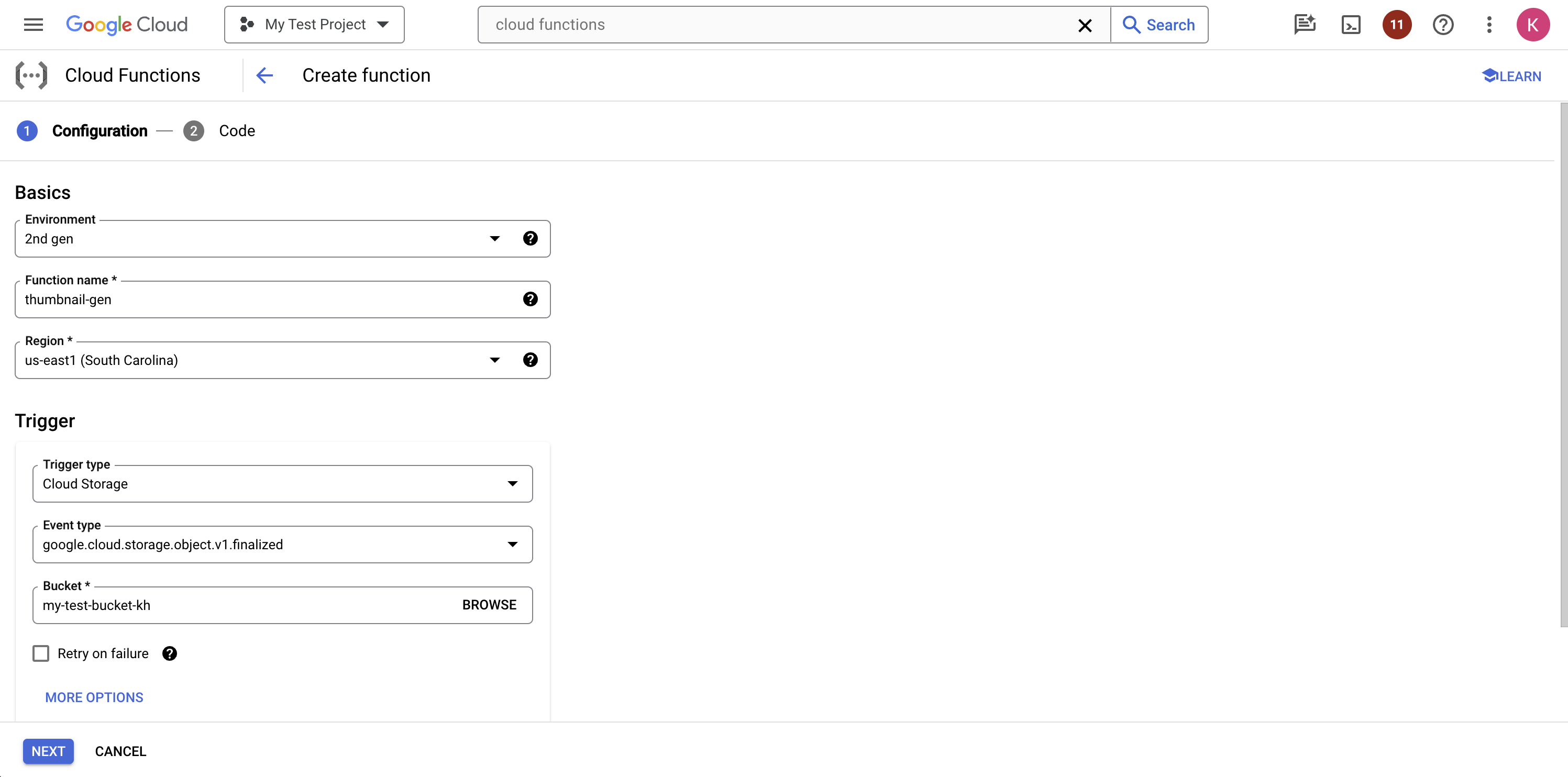
Click the Next button. Now, paste the following code into the `index.js` file to define the function:
const functions = require('@google-cloud/functions-framework');
const { Storage } = require('@google-cloud/storage');
const path = require("path")
const sharp = require('sharp');
functions.cloudEvent('helloGCS', async cloudEvent => {
const file = cloudEvent.data;
// Don't run for thumbnails
if (file.name.includes("_thumb")) {
return
}
const storage = new Storage();
const bucketRef = storage.bucket(file.bucket);
const fileRef = bucketRef.file(file.name);
const name = file.name.split("/")[1];
try {
await fileRef.download({ destination: name });
console.log(`Downloaded file: ${name}`);
sharp(name)
.resize(320, 240)
.toFile(name.split(".")[0] + "_thumb." + name.split(".")[1], async (err, info) => {
await bucketRef.upload(
name.split(".")[0] + "_thumb." + name.split(".")[1],
{
destination: file.name.split("/")[0] + "/" + name.split(".")[0] + "_thumb." + name.split(".")[1]
});
console.log(`Uploaded thumbnail: ${name.split(".")[0] + "_thumb." + name.split(".")[1]}`);
});
} catch (error) {
console.error(`Error generating thumbnail: ${error}`);
}
});
{
"dependencies": {
"@google-cloud/functions-framework": "^3.0.0",
"@google-cloud/storage": "7.8.0",
"sharp": "0.33.2"
}
}
This is a simple function that listens for events in your chosen bucket. When a new photo is uploaded to any folder in the bucket, the function downloads it locally, creates a thumbnail for it using sharp, and then uploads it to the same bucket at the same location.
Click the blue Deploy button at the bottom to deploy the function. GCP will start to deploy your Cloud Function. Once deployed, you can try creating a folder and adding files to it. After a short time, a thumbnail of that photo will be available in the same folder. This demonstrates that the function works and is doing its job correctly.
Implementing PoLP through a custom service account
Let’s now look at the major security issue associated with this function and how you can implement PoLP to mitigate it.
Currently, it uses the Compute Engine default service account, which you can confirm by going to the Details tab on the Function details page:

This means it has assumed an Editor role within its GCP project. This role comes with around 8,000 permissions throughout your GCP project, but this function only needs the permissions `storage.objects.get` and `storage.objects.create`.
However, you cannot assign permissions to service accounts directly. You can only assign roles to them, which in turn are granted permissions. To limit this function’s permissions, you could assign it the Cloud Storage Object Admin role, but this role also contains five additional permissions on top of the two you need. While it’s better than having over 8,000 unnecessary permissions, it’s not exactly the “least privilege” approach.
To solve this problem and adhere to PoLP, you’ll need to create a custom role with only these two permissions. You can do that by navigating to the Create role page. Give your new role a name and an ID, and click the + Add Permissions button to add the two permissions you need for your Cloud Function. Once done, the page should display your two permissions with checkboxes under the 2 assigned permissions label:
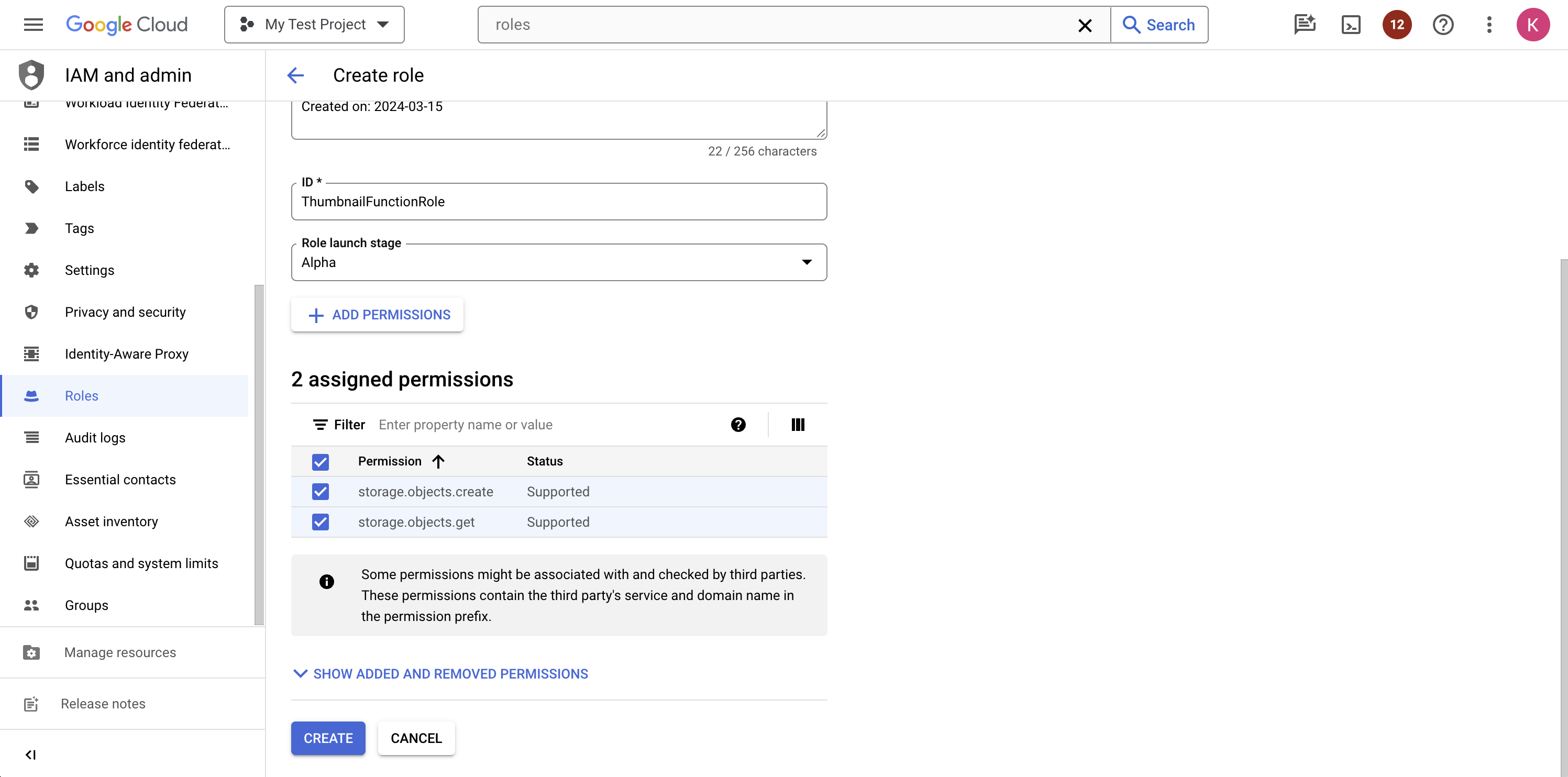
Click the Create button to create the role.
Alternatively, you could also use the following `gcloud` command to create the role through the CLI:
gcloud iam roles create ThumbnailFunctionRole --project="PROJECT_ID" --title="thumbnail-function-role" --permissions="storage.objects.create,storage.objects.get"
You can now navigate to the Create service account page to start creating a new account.
Start by providing a name for your new service account. A service account ID will automatically be generated for you from the name you enter. Click Create and continue.
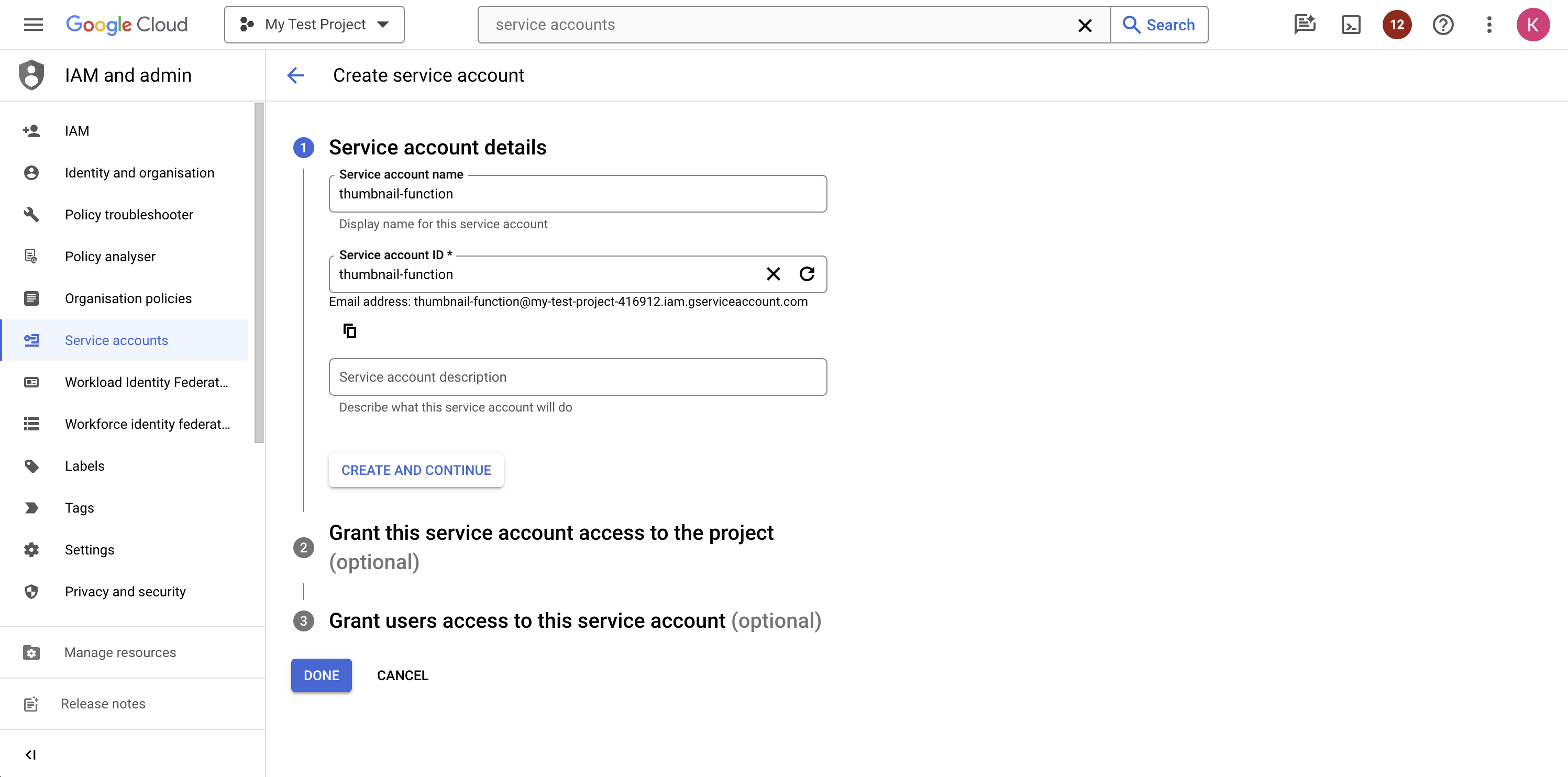
Next, you need to grant this service account the role that you need your function to have. Click the Select a role dropdown menu. Search for the thumbnail function role and select it. Click + Add IAM condition to add a condition that checks for the bucket name before allowing access to it. Enter a title like `Only for the bucket [BUCKET_NAME]`, choose the condition type `Name` and operator `is`, and enter the value as `projects/_/buckets/[BUCKET_NAME]`:
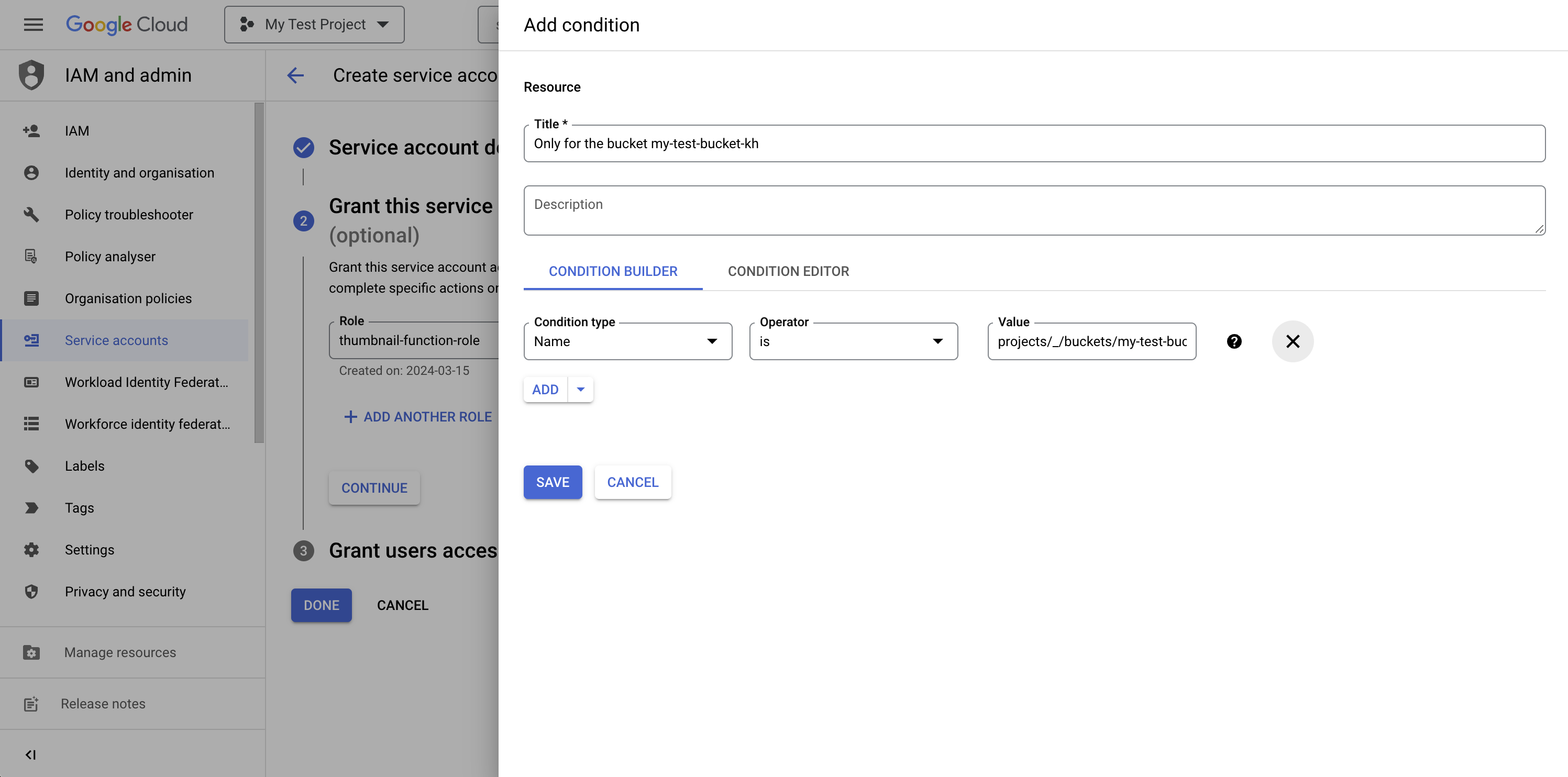
Click the Save button. You’ll be taken to the Create service account page, which has some optional configurations that you can ignore for this tutorial.
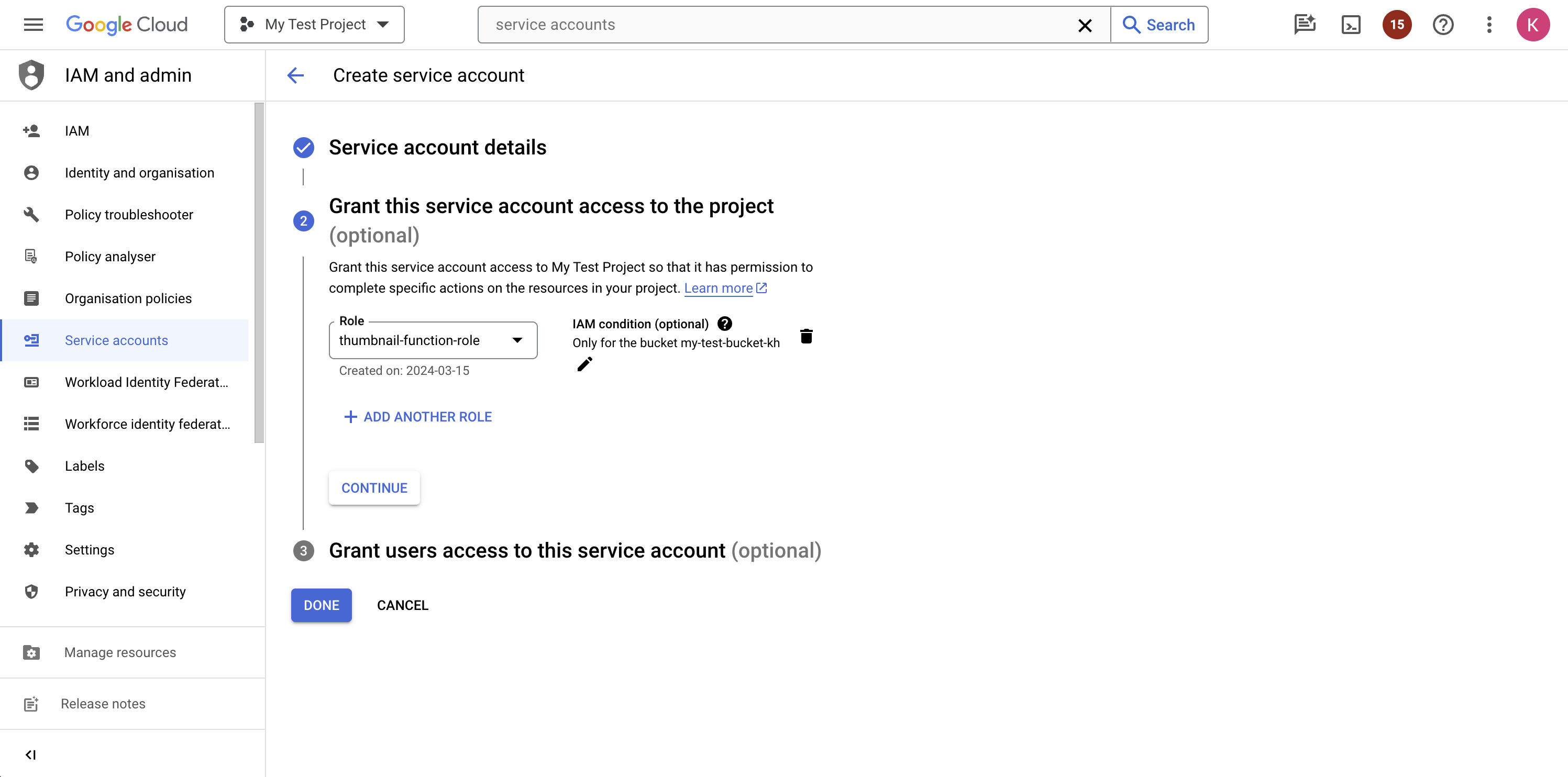
Click the Continue button and click Done on the last step. Your new service account with just the right permissions is ready.
Alternatively, you could use the following `gcloud` commands to create the service account and add the roles:
gcloud iam service-accounts create thumbnail-function
gcloud projects add-iam-policy-binding [PROJECT_ID] --member="serviceAccount:[SERVICE_ACCOUNT_NAME]@[PROJECT_ID].iam.gserviceaccount.com" --role="projects/[PROJECT_ID]/roles/ThumbnailFunctionRole" --condition='expression=resource.name == "projects/_/buckets/[BUCKET_NAME]",title=Only for the bucket my-test-bucket-kh'
Your service account is now ready. You can go back to your Cloud Function and redeploy it while binding it to the new service account.
Go back to the Function details page and click the Edit button:
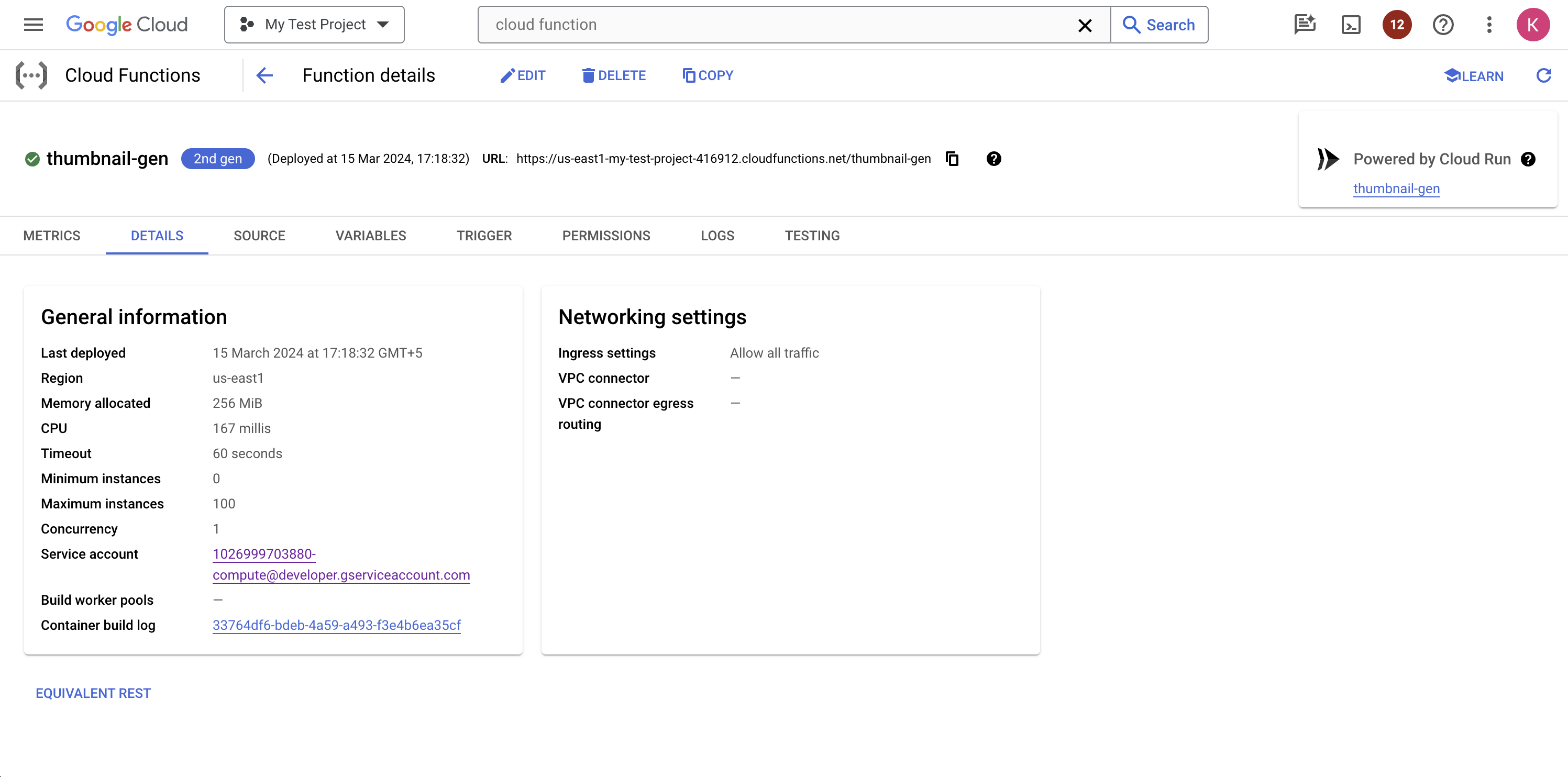
Scroll down and expand the Runtime, build, connections and security settings section. In that section, scroll down to the Runtime service account subsection and choose your new service account in the Service account dropdown menu:
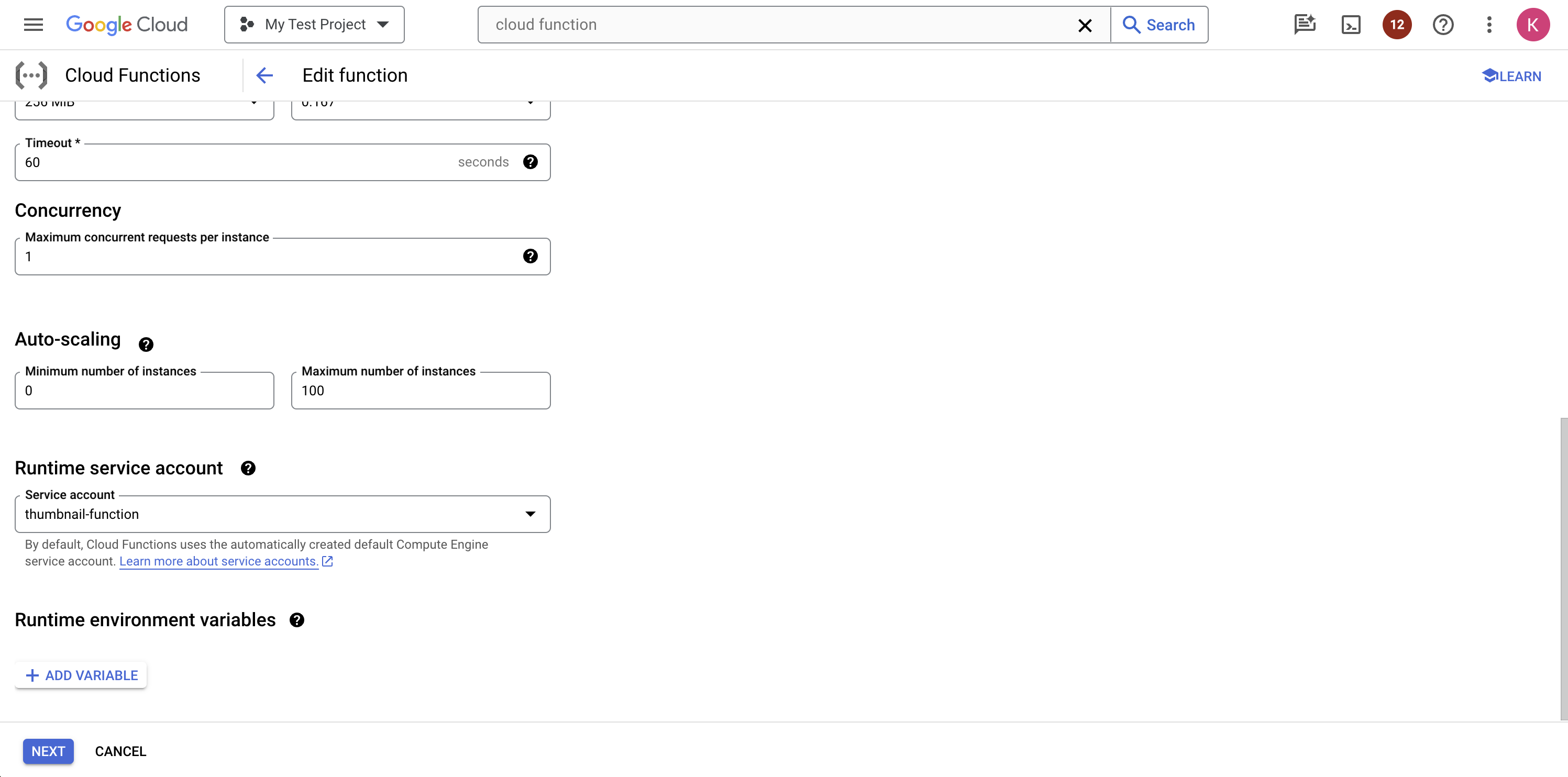
Click Next at the bottom of the page, then click Deploy on the next page.
Alternatively, you could use the following `gcloud` command to redeploy the function with the new service account:
gcloud functions deploy thumbnail-gen \
--service-account "[SERVICE_ACCOUNT_NAME]@[PROJECT_ID].iam.gserviceaccount.com"
Once deployed, the function will now only have the two permissions `storage.objects.get` and `storage.objects.create`. You can try uploading a photo to the bucket once again to see if it works correctly.
When calling other functions
Cloud Functions are often designed to call other functions to modularize business logic and implement a better separation of concerns. In such cases, the function to be called will have an HTTP trigger, since event-driven functions like the one you saw above can only be invoked by the event sources.
When one Cloud Function, let’s say Function A, calls another Cloud Function, let’s say Function B, there are multiple things you need to do to restrict access to only the necessary permissions.
First of all, you need to set Function B to require authentication. You can usually do that when creating the function by clicking the radio button next to Require authentication under Authentication in the Trigger section:
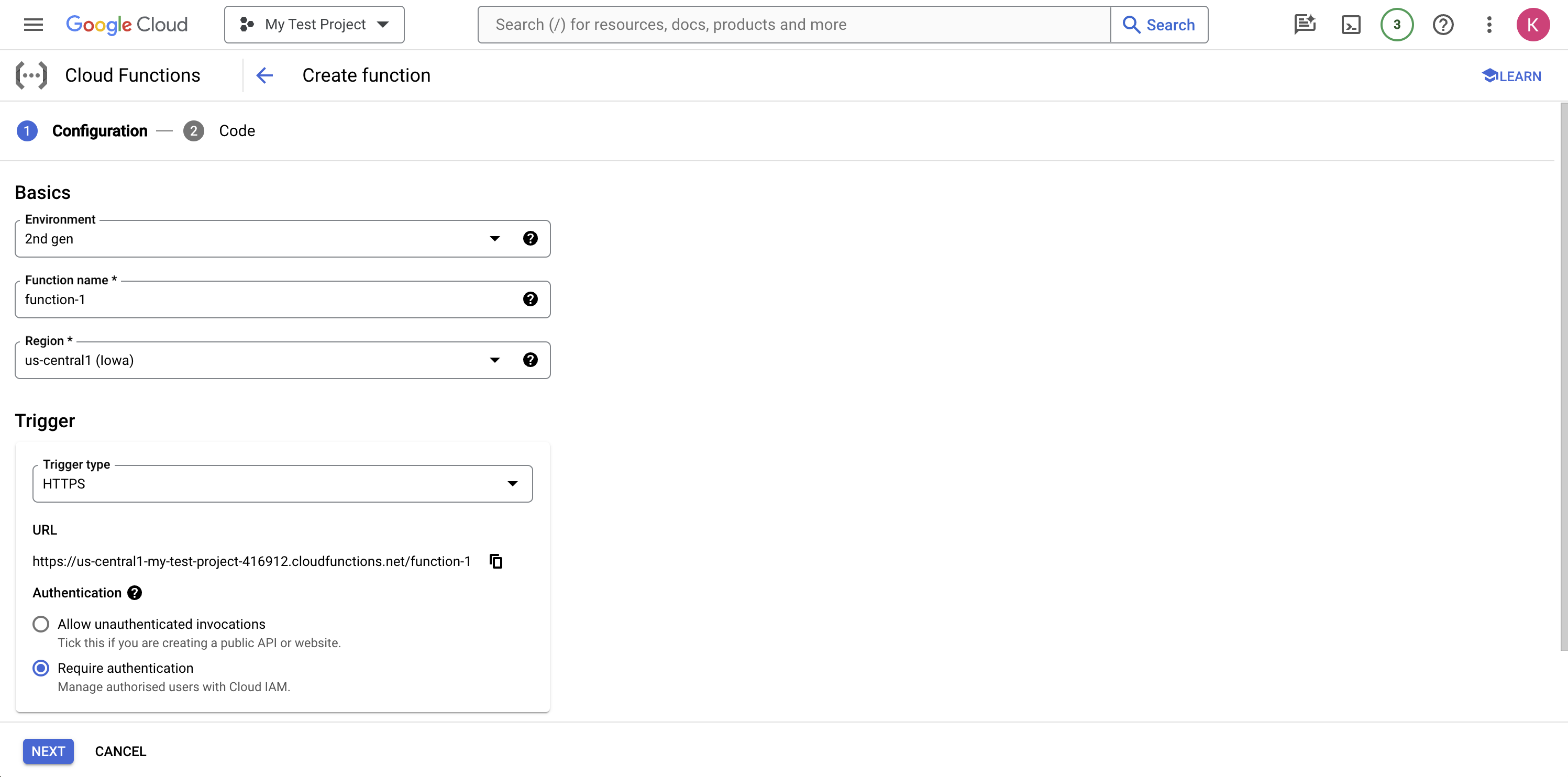
Additionally, you could also edit an existing function and set the same value.
Next, you need to provide the calling function (Function A) with the `cloudfunctions.functions.invoke` permission if the called function (Function B) is a 1st gen function, or the `run.routes.invoke` permission if the called function (Function B) is a 2nd gen function. Without these permissions, no principal can invoke authenticated Cloud Functions.
You can attach the `roles/cloudfunctions.invoker` role to your custom service account for 1st gen functions or the `roles/run.invoker` role for 2nd gen functions.
Finally, you need to pass in a Google-signed identity token when calling Function B. You can follow the steps outlined here to use one of Google’s Auth SDKs to generate the ID token, or add the following lines to your function (for Node.js) to fetch the ID token manually:
// Install and import node-fetch
// const fetch = require('node-fetch');
const headers = new fetch.Headers({
'Metadata-Flavor': 'Google'
});
const functionBUrl = 'https://[REGION]-[PROJECT_ID].cloudfunctions.net/functionB;
// Set up metadata server request to get a token
const metadataServerTokenURL = 'http://metadata/computeMetadata/v1/instance/service-accounts/default/identity?audience=';
const response = await fetch(metadataServerTokenURL + otherFunction, {
method: "POST",
headers: headers
})
You can now pass the retrieved token in the header of the call to Function B as `Authorization: Bearer [ID_TOKEN]`. Requests that do not contain such a token will automatically be rejected by the called function (Function B).
When calling GCP services not restricted by Cloud IAM policies
When calling GCP services that do not work with Cloud IAM policies, you can use the same Google-signed ID tokens to authenticate your calls. For instance, when making calls to a Compute Engine VM, you can generate a Google-signed ID token using the same method mentioned in the previous section—replace the `functionBUrl` with the URL to which you are sending your request—and pass it as a bearer token in your HTTP requests.
On the service side, you can validate the token yourself to make sure the request is coming from a verified source. Google provides detailed instructions to validate the token here.
Conclusion
In this article, you learned about the importance of the principle of least privilege and how to implement it for Cloud Functions. By following a least privilege approach, you can minimize the attack surface of your Cloud Functions and improve the overall security of your project.
To simplify Cloud Function IAM management at scale, consider using ConductorOne, a comprehensive cloud IAM platform that helps you enforce least privilege and automate IAM policies across your GCP resources.
